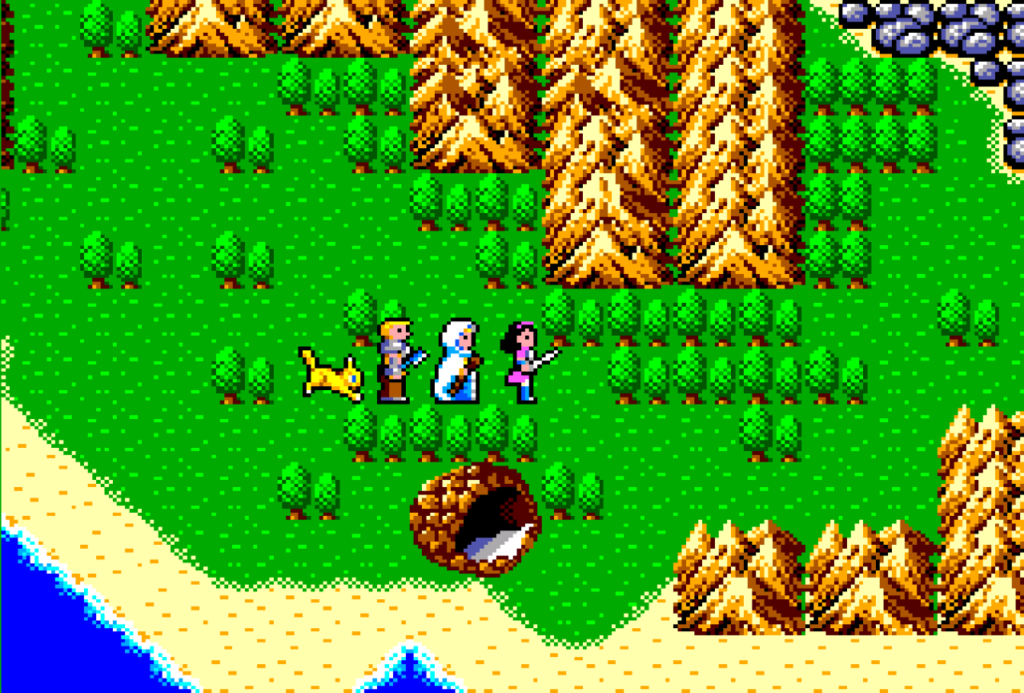Phantasy Star is a top-down perspective rpg that switches to a first person perspective during combat encounters and exploring dungeons. It was released in 1987 by Sega for the master system. Set in the Algol system centuries in the future, Alice is on a mission to avenge her brother’s death. There are three planets you explore before defeating the final boss “Dark Falz”.
Whenever I hear the music from Phantasy Star I get an immediate serotonin boost. I remember walking around in grass, through mountains, gaining companions along the way, and being transported to another world. What made the game special to me was my self-identification with Alice. She looked like me, and I imagined that I was her in the game. This experience revealed to me how important representation is in video games. Phantasy Star is a women empowering game through its narrative, genre, and game design. There should be more diverse characters in video games to encourage player connection for everyone.

First, narrative. Alice is on a quest to defeat Lassic. She fights creatures with a cool sword and the narrative seems typical of an rpg. Despite being a woman protagonist, Alice does not deal with common tropes found other media. She is the active protagonist making the story go forward, doesn’t have a love interest driving the plot, and is not to be saved by someone else. This is important for women in media because it is an opportunity to feel empowered in womanhood. Especially as a young girl playing the game, I thought Alice was really cool, and she made me feel more confident.
Phantasy Star combines the sci-fi and fantasy genre to create an rpg that is incredibly captivating. In Henry Jenkins article, Game Design as Narrative Architecture, he writes, “As such, games fit within a much older tradition of spatial stories, which have often taken the form of hero’s odysseys, quest myths, or travel narratives”. Phantasy Star does not spend a lot of time on its narrative. You put together the story from cut scenes in the game, and the rest of the time you walk around fighting monsters and talking to townspeople. So the majority of the player’s time is spent in the sci-fi/medieval world of the game. This follows what Jenkins describes as the tradition of spatial stories. A lot of the narrative is the world itself and experiencing the environment. This way of experiencing the narrative through a spatial lens focuses the player more on the feeling of being in the world of the story. With Alice as the avatar I was able to place myself in the world and feel like I was exploring this futuristic fantasy world where you used spaceships to fly to other planets and used swords to fight dragons.

For game design, I will be talking about the turn based combat system, dungeon-delving, and music. Many fps shooters and rpgs rely on reflexes, providing a barrier to entry for those who aren’t comfortable playing games like this. Phantasy Star’s turn based combat system provides combat at your own pace. There are no time limits, you pick from the drop menus what action you wish each character to take and then whoever/whatever you’re fighting counterstrikes. This makes Phantasy Star accessible to those who like combat in games and those who prefer a game experience that doesn’t require fast reflexes. Next, when talking about the dungeons, their first person perspective is very impressive. The animations are smooth and is one of the main features of the game. Instead of a top down map perspective, the player has the point of view of Alice, making it more challenging to navigate the mazes. I remember making maps with my dad of the different levels, it asks the player to come up with strategies on how to get through the mazes. Lastly on the topic of game design, the music of Phantasy Star was very cheery and stuck in your head, it was one of the most memorable things of the game. You spend a lot of hours grinding in Phantasy Star, and I never tired of the music since it enhanced my gameplay experience. The long hours of grinding may be a barrier for some players. It’s a lot of repetition, fighting monsters to save up mesetas to buy the next thing necessary for the plot. I never finished the game despite playing it several times since I would usually tire before reaching the end of the plot. It wasn’t until I watched a let’s play that I found out what the ending is. However, this wasn’t a negative for me, I rarely complete the main quest of rpg games. But it can also be annoying if you want to reach the narrative end of the game.

I’ll always remember how Phantasy Star made me feel. It increased my self confidence, fostered my interest in technology, and made me feel good. The stories we tell are opportunities for imagining how we want ourselves to be. Having more diversity of characters in appearance and background in video game rpgs such as Phantasy Star, would give these opportunities to more people in a meaningful way.

